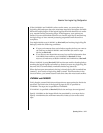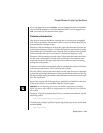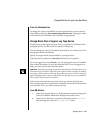
3-14 IBM Informix OnLine Database Server Administrator’s Guide
Examine Your Logical Log Configuration
Examine Your Logical Log Configuration
Complete the tasks outlined here to examine your logical log configuration
and to verify that it is appropriate for your OnLine environment.
Your Configuration File
To examine your specified configuration, you need a copy of your OnLine
configuration file, $INFORMIXDIR/etc/$TBCONFIG. Execute tbstat -c while
OnLine is running.
The configuration displayed by
DB-Monitor (Status menu, Configuration
option) is a copy of your current OnLine configuration, which could differ
from the values stored in your configuration file.
For further information about the relationship of the current configuration to
the values in the configuration file ($INFORMIXDIR/etc/$TBCONFIG), refer
to page 1-11.
Logical Log File Backups
During OnLine operation, transaction log records are stored on disk in the
logical log files. When the current logical log file becomes full, OnLine
switches to the next one. When OnLine reaches the last defined logical log
file, it repeats the sequence in a never-ending loop. (Refer to page 3-27 for
more information about the rotation of the logical log files.)
It is the operator’s responsibility to back up each logical log file to tape or to
/dev/null as it becomes full. The log file data is crucial in the event of a failure.
The logical log files compose a record of all database activity from the time of
the last archive. If a failure occurs, you can restore all data up to the point of
the failure by first restoring the archive tapes and then rolling forward the
transaction records saved in the logical log file backups. Without the logical
log file backup tapes, you can restore your data only to the point of your
most-recent archive.


















